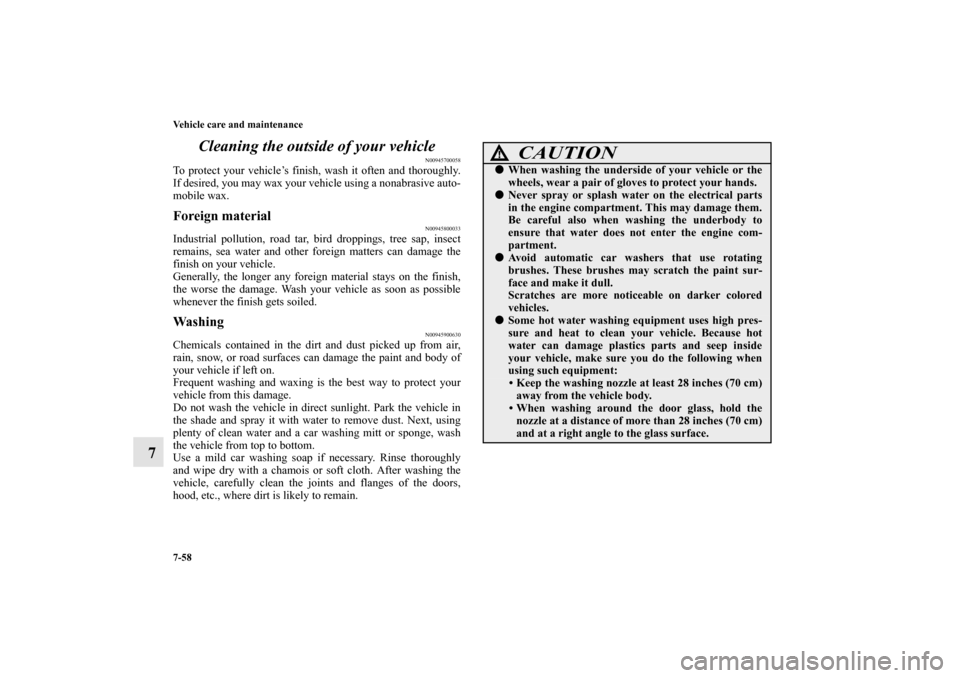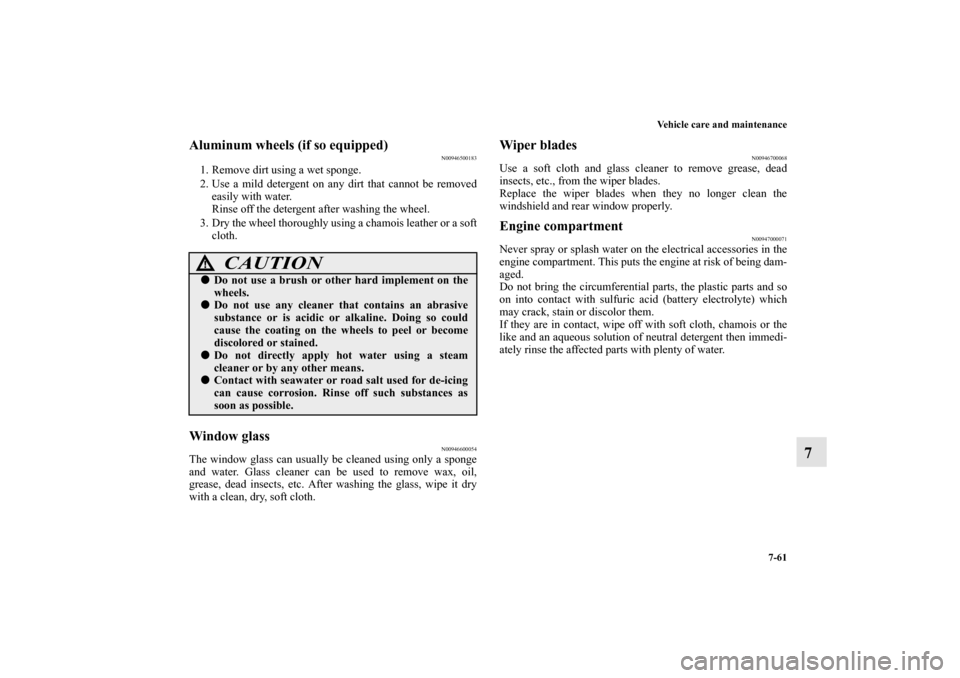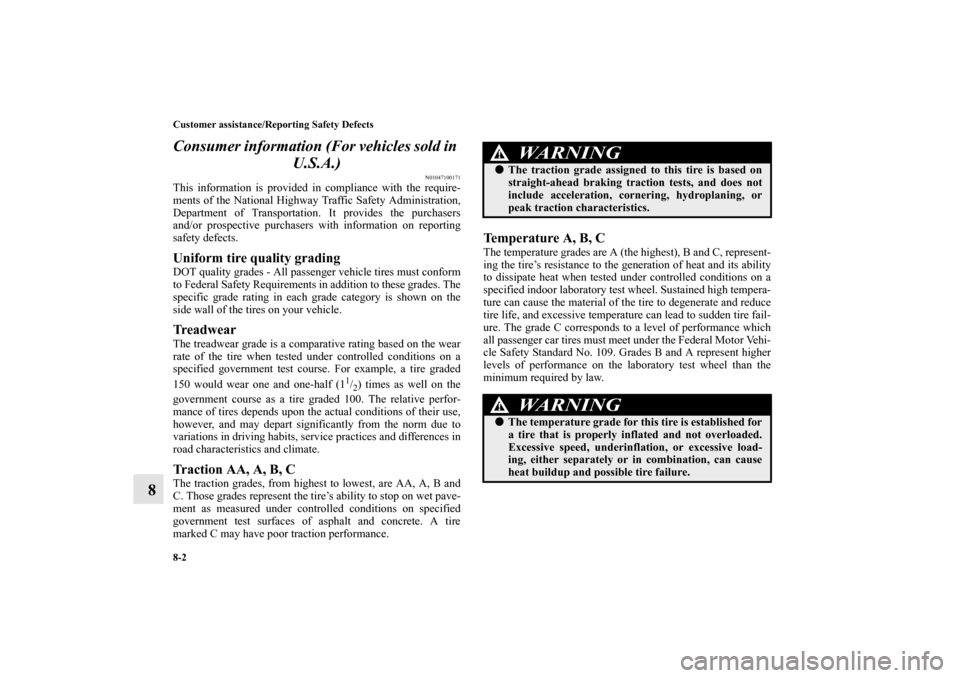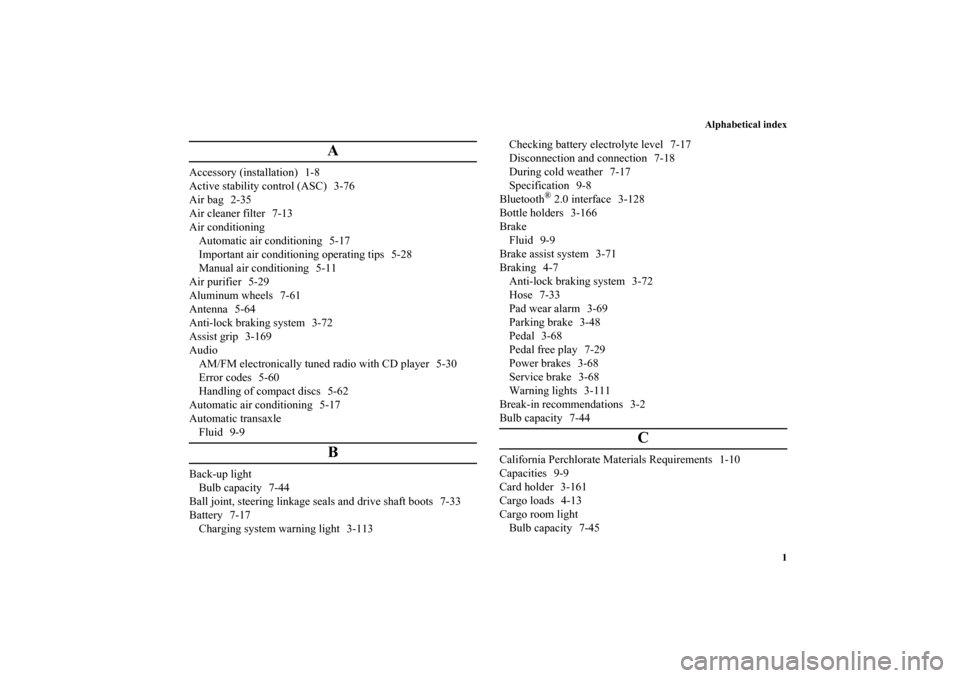Page 424 of 460
7-50 Vehicle care and maintenance
7
Front fog lights
(if so equipped)
N00943600763
1. To create enough work space, turn the steering wheel all
the way in the direction opposite to the side you wish to
replace.
2. Remove the clips/bolts (A) to turn up the cover (B).3. While pressing the tab (C), pull out the connector (D).
4. Turn the bulb (E) counterclockwise to remove it.
BK0162600US.book 50 ページ 2013年3月22日 金曜日 午後2時41分
Page 432 of 460

7-58 Vehicle care and maintenance
7Cleaning the outside of your vehicle
N00945700058
To protect your vehicle’s finish, wash it often and thoroughly.
If desired, you may wax your vehicle using a nonabrasive auto-
mobile wax.Foreign material
N00945800033
Industrial pollution, road tar, bird droppings, tree sap, insect
remains, sea water and other foreign matters can damage the
finish on your vehicle.
Generally, the longer any foreign material stays on the finish,
the worse the damage. Wash your vehicle as soon as possible
whenever the finish gets soiled.Wa s h i n g
N00945900630
Chemicals contained in the dirt and dust picked up from air,
rain, snow, or road surfaces can damage the paint and body of
your vehicle if left on.
Frequent washing and waxing is the best way to protect your
vehicle from this damage.
Do not wash the vehicle in direct sunlight. Park the vehicle in
the shade and spray it with water to remove dust. Next, using
plenty of clean water and a car washing mitt or sponge, wash
the vehicle from top to bottom.
Use a mild car washing soap if necessary. Rinse thoroughly
and wipe dry with a chamois or soft cloth. After washing the
vehicle, carefully clean the joints and flanges of the doors,
hood, etc., where dirt is likely to remain.
CAUTION
!�When washing the underside of your vehicle or the
wheels, wear a pair of gloves to protect your hands.�Never spray or splash water on the electrical parts
in the engine compartment. This may damage them.
Be careful also when washing the underbody to
ensure that water does not enter the engine com-
partment.�Avoid automatic car washers that use rotating
brushes. These brushes may scratch the paint sur-
face and make it dull.
Scratches are more noticeable on darker colored
vehicles.�Some hot water washing equipment uses high pres-
sure and heat to clean your vehicle. Because hot
water can damage plastics parts and seep inside
your vehicle, make sure you do the following when
using such equipment:
• Keep the washing nozzle at least 28 inches (70 cm)
away from the vehicle body.
• When washing around the door glass, hold the
nozzle at a distance of more than 28 inches (70 cm)
and at a right angle to the glass surface.
BK0162600US.book 58 ページ 2013年3月22日 金曜日 午後2時41分
Page 435 of 460

Vehicle care and maintenance
7-61
7
Aluminum wheels (if so equipped)
N00946500183
1. Remove dirt using a wet sponge.
2. Use a mild detergent on any dirt that cannot be removed
easily with water.
Rinse off the detergent after washing the wheel.
3. Dry the wheel thoroughly using a chamois leather or a soft
cloth.Window glass
N00946600054
The window glass can usually be cleaned using only a sponge
and water. Glass cleaner can be used to remove wax, oil,
grease, dead insects, etc. After washing the glass, wipe it dry
with a clean, dry, soft cloth.
Wiper blades
N00946700068
Use a soft cloth and glass cleaner to remove grease, dead
insects, etc., from the wiper blades.
Replace the wiper blades when they no longer clean the
windshield and rear window properly.Engine compartment
N00947000071
Never spray or splash water on the electrical accessories in the
engine compartment. This puts the engine at risk of being dam-
aged.
Do not bring the circumferential parts, the plastic parts and so
on into contact with sulfuric acid (battery electrolyte) which
may crack, stain or discolor them.
If they are in contact, wipe off with soft cloth, chamois or the
like and an aqueous solution of neutral detergent then immedi-
ately rinse the affected parts with plenty of water.
CAUTION
!�Do not use a brush or other hard implement on the
wheels.�Do not use any cleaner that contains an abrasive
substance or is acidic or alkaline. Doing so could
cause the coating on the wheels to peel or become
discolored or stained.�Do not directly apply hot water using a steam
cleaner or by any other means.�Contact with seawater or road salt used for de-icing
can cause corrosion. Rinse off such substances as
soon as possible.
BK0162600US.book 61 ページ 2013年3月22日 金曜日 午後2時41分
Page 438 of 460

8-2 Customer assistance/Reporting Safety Defects
8Consumer information (For vehicles sold in
U.S.A.)
N01047100171
This information is provided in compliance with the require-
ments of the National Highway Traffic Safety Administration,
Department of Transportation. It provides the purchasers
and/or prospective purchasers with information on reporting
safety defects. Uniform tire quality gradingDOT quality grades - All passenger vehicle tires must conform
to Federal Safety Requirements in addition to these grades. The
specific grade rating in each grade category is shown on the
side wall of the tires on your vehicle. Treadwear The treadwear grade is a comparative rating based on the wear
rate of the tire when tested under controlled conditions on a
specified government test course. For example, a tire graded
150 would wear one and one-half (1
1/2) times as well on the
government course as a tire graded 100. The relative perfor-
mance of tires depends upon the actual conditions of their use,
however, and may depart significantly from the norm due to
variations in driving habits, service practices and differences in
road characteristics and climate.
Traction AA, A, B, C The traction grades, from highest to lowest, are AA, A, B and
C. Those grades represent the tire’s ability to stop on wet pave-
ment as measured under controlled conditions on specified
government test surfaces of asphalt and concrete. A tire
marked C may have poor traction performance.
Temperature A, B, CThe temperature grades are A (the highest), B and C, represent-
ing the tire’s resistance to the generation of heat and its ability
to dissipate heat when tested under controlled conditions on a
specified indoor laboratory test wheel. Sustained high tempera-
ture can cause the material of the tire to degenerate and reduce
tire life, and excessive temperature can lead to sudden tire fail-
ure. The grade C corresponds to a level of performance which
all passenger car tires must meet under the Federal Motor Vehi-
cle Safety Standard No. 109. Grades B and A represent higher
levels of performance on the laboratory test wheel than the
minimum required by law.
WA R N I N G
!�The traction grade assigned to this tire is based on
straight-ahead braking traction tests, and does not
include acceleration, cornering, hydroplaning, or
peak traction characteristics.
WA R N I N G
!�The temperature grade for this tire is established for
a tire that is properly inflated and not overloaded.
Excessive speed, underinflation, or excessive load-
ing, either separately or in combination, can cause
heat buildup and possible tire failure.
BK0162600US.book 2 ページ 2013年3月22日 金曜日 午後2時41分
Page 443 of 460
9
Specifications
Vehicle labeling . . . . . . . . . . . . . . . . . . . . . . . . . . .9- 2
Vehicle dimensions . . . . . . . . . . . . . . . . . . . . . . . .9- 5
Vehicle weights . . . . . . . . . . . . . . . . . . . . . . . . . . .9- 6
Engine specifications . . . . . . . . . . . . . . . . . . . . . . .9- 7
Battery . . . . . . . . . . . . . . . . . . . . . . . . . . . . . . . . . .9- 8
Tires and wheels. . . . . . . . . . . . . . . . . . . . . . . . . . .9- 8
Capacity . . . . . . . . . . . . . . . . . . . . . . . . . . . . . . . . .9- 9
BK0162600US.book 1 ページ 2013年3月22日 金曜日 午後2時41分
Page 447 of 460
Specifications
9-5
9
Certification label
N01148200242
The certification label is located on the driver’s door sill.
Vehicle dimensions
N01147500541
Overall length 148.8 in (3,780 mm)Overall width 65.6 in (1,665 mm)Overall height 59.1 in (1,500 mm)Wheel base 96.5 in (2,450 mm)
BK0162600US.book 5 ページ 2013年3月22日 金曜日 午後2時41分
Page 450 of 460
9-8 Specifications
9Battery
N01147800296
Battery is a 12 volt type.
Tires and wheels
N01147900747
PCD: Pitch Circle Diameter (installation holes)NOTE�Contact an authorized Mitsubishi Motors dealer for details
on the combination used on your vehicle.
�These tires satisfy vehicle loading conditions described in
this owner’s manual.
55D23L (356CCA/99RC)
Tire 165/65R14Wheel
Size 14 x 4 1/2JPCD 3.93 in (100 mm)Offset 1.81 in (46 mm)
BK0162600US.book 8 ページ 2013年3月22日 金曜日 午後2時41分
Page 453 of 460

Alphabetical index
1
A
Accessory (installation) 1-8
Active stability control (ASC) 3-76
Air bag 2-35
Air cleaner filter 7-13
Air conditioning
Automatic air conditioning 5-17
Important air conditioning operating tips 5-28
Manual air conditioning 5-11
Air purifier 5-29
Aluminum wheels 7-61
Antenna 5-64
Anti-lock braking system 3-72
Assist grip 3-169
Audio
AM/FM electronically tuned radio with CD player 5-30
Error codes 5-60
Handling of compact discs 5-62
Automatic air conditioning 5-17
Automatic transaxle
Fluid 9-9
B
Back-up light
Bulb capacity 7-44
Ball joint, steering linkage seals and drive shaft boots 7-33
Battery 7-17
Charging system warning light 3-113Checking battery electrolyte level 7-17
Disconnection and connection 7-18
During cold weather 7-17
Specification 9-8
Bluetooth
® 2.0 interface 3-128
Bottle holders 3-166
Brake
Fluid 9-9
Brake assist system 3-71
Braking 4-7
Anti-lock braking system 3-72
Hose 7-33
Pad wear alarm 3-69
Parking brake 3-48
Pedal 3-68
Pedal free play 7-29
Power brakes 3-68
Service brake 3-68
Warning lights 3-111
Break-in recommendations 3-2
Bulb capacity 7-44
C
California Perchlorate Materials Requirements 1-10
Capacities 9-9
Card holder 3-161
Cargo loads 4-13
Cargo room light
Bulb capacity 7-45
BK0162600US.book 1 ページ 2013年3月22日 金曜日 午後2時41分